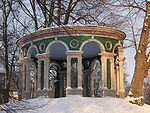Gustav III's Pavilion
1787 establishments in SwedenBuildings and structures in Stockholm CountyCrown palaces in SwedenGustav IIIHistoric house museums in Sweden ... and 2 more
Houses completed in 1787Museums in Stockholm County

Gustav III's Pavilion (Swedish: Gustav III:s paviljong) is a royal pavilion at the Haga Park, 2 km north of Stockholm. As a highlight in Swedish art history, the Pavilion is a fine example of the European neoclassicism of the late 18th century in Northern Europe. Beside the Pavilion lie the "Sultan's Copper Tents", buildings designed to resemble big tents.
Excerpt from the Wikipedia article Gustav III's Pavilion (License: CC BY-SA 3.0, Authors, Images).Gustav III's Pavilion
Haga södra grindar, Solna kommun
Geographical coordinates (GPS) Address External links Nearby Places Show on map
Geographical coordinates (GPS)
| Latitude | Longitude |
|---|---|
| N 59.362777777778 ° | E 18.039166666667 ° |
Address
Gustav III:s paviljong
Haga södra grindar
171 76 Solna kommun, Solna Kyrkby
Sweden
Open on Google Maps










